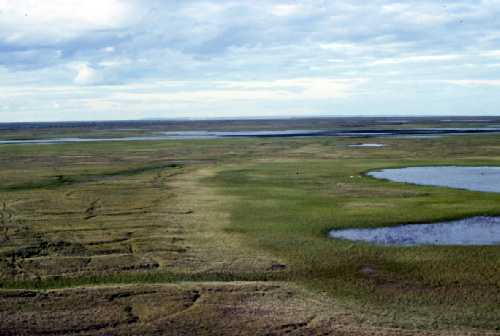Site Map: |
| Imnavait Watershed Sites
Upper Kuparuk Watershed Sites Western Kuparuk Sites Eastern Kuparuk Sites Coastal Plain Sites General Info |

PHOTO: Larry Hinzman, WERC |
||||||
|
The northern-most monitoring sites on the Kuparuk Watershed Study are located on the Arctic Coastal Plain of Alaska (approx. 70o 16'N, 148o 53'W). This area is a vast expanse of flat topography dominated by wetlands, ponds, and lakes. Numerous permafrost features also exist like high and low centered polygons, pingos, strangmoor ridges, and hummocky ground (Kane et. al 2000). The vegetation of this area varies from tussock tundra in higher, drier ground to sedges and grasses in wetter areas.
The Betty Pingo site is located in a small wetland watershed (8.15 ha) on the southern edge of the Prudhoe Bay oil field (Mendez et al. 1998). The site is at an elevation of about 12 meters. The vegetation consists of wet sedge tundra and forb tundra. The soils are organic overlying layers of fine sand and silts. The 10 meter tower was established in a wetland area, however nearby dryer areas were also equipped with soil thermistors and net radiation instrumentation. The maximum depth of soil thawed above the permafrost averaged 55 cm between 1993 and 1999 (Brown and Hinkel, 2000). The West Dock monitoring station is located close to the arctic ocean, on the west side of Prudhoe Bay. This site is at the edge of a marshy, drained lake basin. Parallel to the east of the Kuparuk River on the coastal plain is the Putuligayuk River. This catchment (471 km2) is unique in that the watershed is totally confined to the low gradient coastal plain. It is dominated by wetlands, ponds and wind-oriented lakes. The USGS monitored this stream for 15 years, from 1970 to 1986 (data for 1980 and 1981 missing). There are no corresponding precipitation data to complement the runoff data. We have only recently re-initiated monitoring of this watershed (Kane et al. 2000). The Putuligayuk River site is mainly a stream gaging station. However, complete meteorological stations are located at the Betty Pingo and West Dock sites. Variables measured at these sites are wind speed, relative humidity and air temperature at three elevations (with the maximum at 10 m). Wind direction, rainfall and soil temperatures are also measured. Incoming and outgoing long and short wave radiation are measured from before snowmelt until freeze-up. Surface drainage from the Betty Pingo study area is quantified by means of a V-notch weir. At the Betty site, soil moisture is measured automatically for several profiles at three to four depths with time domain reflectometry (TDR), several times per day. The water equivalent of the snowpack is measured late each spring at these sites just before melt begins (Kane et al. 2000). Brown J. and K. Hinkel, 2000. Circumpolar Active Layer Monitoring (CALM) Network. http://www.geography.uc.edu/~kenhinke/CALM/sites.html. Kane, D.L., Hinzman, L.D., McNamara, J.P., Zhang, Z., and Benson, C.S. (2000). An Overview of a Nested Watershed Study in Arctic Alaska, Nordic Hydrology, Vol. 31 (4/5), 245-266. Mendez, J., Hinzman, L.D., and Kane, D.L.(1998). Evapotranspiration from a Wetland Complex on the Arctic Coastal Plain of Alaska, Nordic Hydrology, Vol. 29 (4/5), 303-330. |
||||||
|